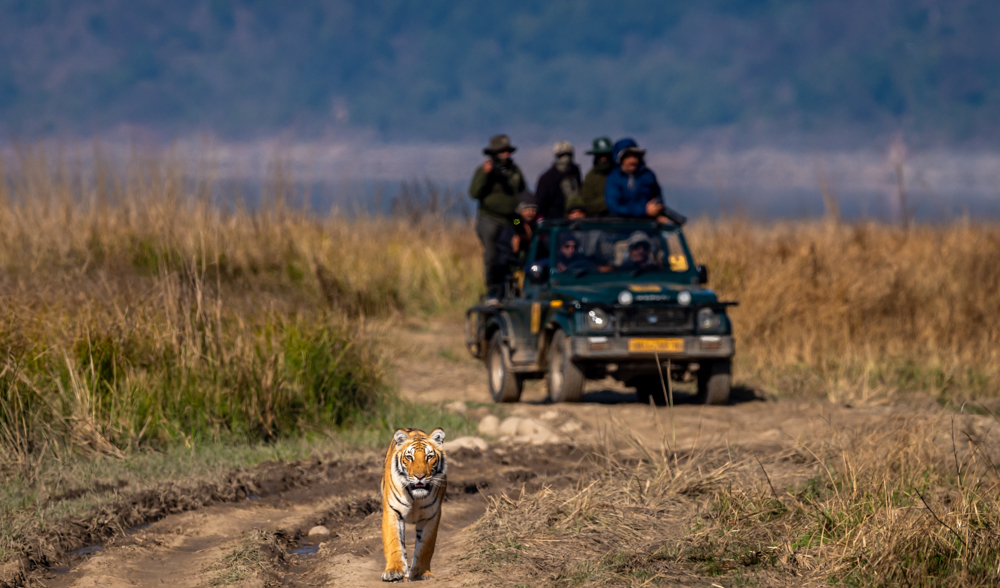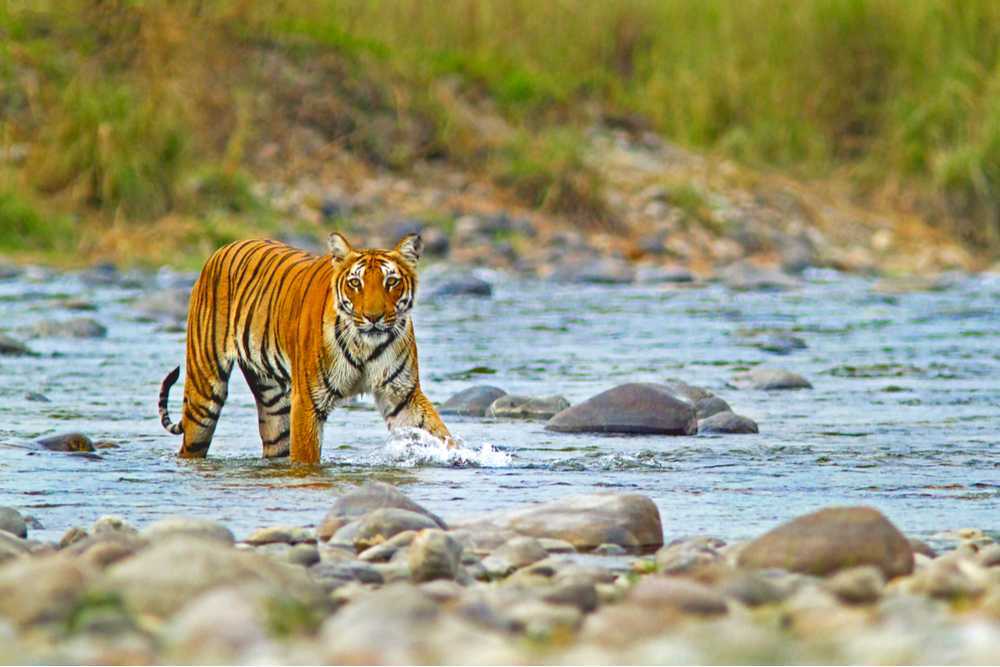Jungle Safari
Published on November 09, 2024
Jungle Safari in Jim Corbett National Park: A Thrilling Adventure in the Wild
If you dream of stepping into a real forest where nature rules and every turn feels like a mystery, a jungle safari in Jim Corbett National Park is an adventure you must experience. Nestled in Uttarakhand, this is India’s oldest national park, established in 1936 to protect the Bengal tiger. Spread over more than 500 square kilometers, it combines thick sal forests, wide grasslands, rivers, and rolling hills. Whether you’re a wildlife lover, a photographer, or simply someone seeking peace in nature, this safari promises something unforgettable.
The Charm of Jim Corbett’s Wilderness
The moment you enter the park, you realize it’s not just about animals—it’s about being part of an untouched world. The air feels fresher, the forest sounds louder, and time seems to slow down. Riding in an open jeep or canter, you feel every curve of the rugged trail as your guide drives deeper into the jungle. You never know what might appear next—spotted deer grazing quietly, langurs swinging between trees, or the deep pugmarks of a tiger on the dusty track.
This raw, untamed feeling is what makes Jim Corbett so special. It’s not a zoo where animals are caged; it’s their home, and we are only visitors.

Types of Safaris in Jim Corbett National Park
-
Jeep Safari: The most popular way to explore Corbett’s wildlife, jeep safaris provide a close-up experience of the jungle. Visitors ride in open 4x4 jeeps along guided routes, exploring various zones and terrains. Jeep safaris are available in the Bijrani, Jhirna, Durga Devi, and Dhela zones, and offer great chances of spotting animals like tigers, leopards, elephants, deer, and various bird species.
-
Canter Safari: Canter safaris are larger, open vehicles that accommodate more people and operate mainly in the Dhikala zone. This safari is a great option for larger groups and provides an exciting journey through one of the park’s most biodiverse areas. Dhikala is known for its picturesque landscapes and is a prime zone for spotting Bengal tigers, elephants, and other large mammals.
- Elephant Safari: Although limited to specific areas, an elephant safari allows visitors to experience the jungle in a unique way. Being higher up on an elephant offers a different perspective, and the quiet, gentle movement of the elephants lets visitors blend more seamlessly with the jungle, increasing the chance of spotting shy animals.
Best Zones for Jungle Safari in Corbett
Each zone in Corbett offers a unique experience with different wildlife sightings, landscapes, and vegetation. Here’s a look at the most popular zones:
-
Dhikala Zone: Known as the best zone for spotting tigers and elephants, Dhikala offers expansive grasslands, dense sal forests, and stunning views of the Ramganga River. Canter safaris are especially popular here, and the zone provides rich photographic opportunities and breathtaking landscapes.
-
Bijrani Zone: Bijrani is another top choice for visitors hoping to see tigers, deer, and a variety of bird species. This zone has beautiful grasslands and forested areas, making it ideal for photography and wildlife spotting.
-
Jhirna Zone: Open year-round, Jhirna is known for its rugged terrain and good sightings of sloth bears, leopards, and wild boars. The zone’s dense forest cover makes it a great habitat for diverse wildlife.
-
Durga Devi Zone: Known for its steep hills and dense forest, Durga Devi zone is a paradise for bird-watchers. It also offers a chance to see leopards and elephants, especially near the Ramganga River.
-
Dhela Zone: Recently opened to the public, Dhela is a quieter area but has quickly gained popularity for its diverse wildlife, including elephants, deer, and various bird species.

What to Expect on a Jungle Safari
On a jungle safari, expect to be surrounded by the sounds of the wild—chirping birds, rustling leaves, and occasional animal calls. With a knowledgeable guide, you’ll traverse Corbett’s dense forests, vast grasslands, and riverbanks, each offering unique ecosystems and wildlife.
While spotting a tiger is the ultimate thrill, Corbett is home to over 600 species of birds, herds of elephants, sambar deer, and other rare animals. The best times for animal sightings are early in the morning and late in the afternoon, when animals are most active.
Tips for a Memorable Jungle Safari
-
Book in Advance: Corbett safaris are in high demand, especially during peak season (November to June). Book your safari in advance, either through the official Corbett website or an authorized travel agency.
-
Follow Safety Rules: Listen to your guide and maintain silence during the safari. Loud noises can disturb animals and make sightings difficult. Respect the natural habitat and avoid littering.
-
Wear Comfortable Clothing: Wear neutral or earthy colors that blend with the environment. Carry a hat, sunscreen, and sunglasses, as the sun can be intense during the day.
-
Bring Binoculars and Camera: Binoculars are essential for bird-watching and spotting animals at a distance. A camera with a good zoom lens will help capture the beauty of the wildlife and landscapes.
-
Stay Patient and Alert: Wildlife sightings are not guaranteed, so patience is key. Stay alert, listen to your guide, and enjoy the thrill of the natural surroundings.
The Safari Experience: What to Expect
A jungle safari usually takes place twice a day—early morning and late afternoon—the times when animals are most active. The early safari is often magical, with cool mist hanging over the forest floor and soft light piercing through the canopy. As you drive deeper into the forest, every sound becomes more meaningful—the distant call of a peacock, the chatter of monkeys warning each other of danger, or the alarm call of a deer signaling a predator nearby.
Your jeep is guided by an expert naturalist who not only knows the forest trails but also helps you understand animal behavior. While everyone hopes to see the Bengal tiger, the safari is about much more than a single animal. You might encounter wild elephants moving silently through the forest, crocodiles basking near riverbanks, or vibrant birds adding color to the green landscape.
Wildlife Beyond Tigers
Although the tiger is the star attraction, Jim Corbett National Park is home to a wide range of species:
-
Mammals: Leopards, sloth bears, otters, wild boars, and jackals.
-
Birds: Over 600 species including hornbills, kingfishers, eagles, parakeets, and migratory birds during winter.
-
Reptiles: Crocodiles, gharials, and monitor lizards.
This diversity makes the park exciting even if you don’t spot a tiger. Every safari feels different because the forest is always alive with activity.
Best Time to Visit
Jim Corbett is open from mid-November to mid-June, though the Jhirna and Dhela zones remain open year-round.
-
Winter (November to February): Cool weather, lush greenery, and great for birdwatching.
-
Summer (March to June): Hot but the best chance to see big cats and other animals near water sources.
-
Monsoon (July to September): Most zones remain closed due to heavy rains and safety reasons.
Tips for an Unforgettable Safari
-
Book early: Safari permits are limited and often sell out quickly during peak seasons.
-
Choose the right zone: If you want tigers, Dhikala and Bijrani are popular. For birds, go for Durga Devi.
-
Wear earthy-colored clothes: Browns, greens, or greys help you blend with the environment.
-
Carry essentials: A hat, sunglasses, water bottle, and sunscreen.
-
Take binoculars and a camera: Wildlife can appear at a distance, and you won’t want to miss a great shot.
-
Stay silent and alert: Loud noises scare animals away and disturb the peaceful atmosphere.
-
Follow park rules: Never get off the vehicle, feed animals, or litter in the park.
More Than Just a Safari
While the jungle safari is the highlight, Jim Corbett has more to offer. Nearby attractions include Garjia Temple, perched on a rock in the middle of the Kosi River, and the Corbett Museum in Kaladhungi, which tells the story of Jim Corbett, the legendary hunter-turned-conservationist after whom the park is named. You can also enjoy peaceful forest walks in buffer zones, riverside picnics, and even adventure activities like camping and birdwatching tours.

Why This Adventure Is Worth It
A jungle safari in Jim Corbett National Park is not just a sightseeing trip—it’s a journey into nature’s own world. Here, you experience what life is like away from cities and noise, where animals roam freely, and every tree and trail holds a story. The thrill of waiting quietly in an open jeep, heart racing at every sound, and then suddenly spotting wildlife in its natural habitat is something you’ll remember for life.
It’s an adventure filled with surprises. One day you may see a tiger crossing your path, the next you may find yourself surrounded by a herd of elephants or enchanted by the call of a rare bird. And even if you don’t spot a big cat, the peace of the forest, the crisp jungle air, and the sheer beauty of the surroundings make the journey just as rewarding.
Jim Corbett is a reminder that we are visitors in the animal kingdom—and the best way to enjoy it is with respect, patience, and a sense of wonder.
